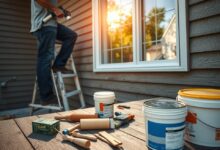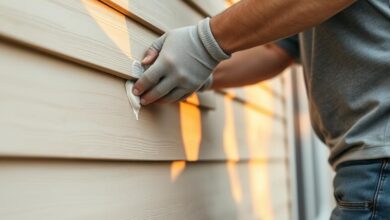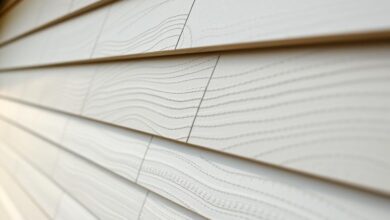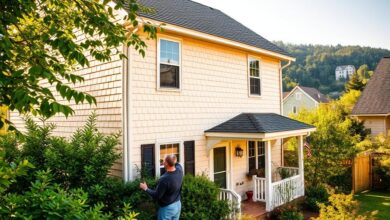Insulated Siding Repair Tips: Expert Advice for DIYers
Maintaining your home’s exterior siding is key for energy savings and looks. As a homeowner, you know fixing issues early is vital.
With the right DIY siding repair methods, you can save money and boost your home’s look. Expert tips will help you keep your insulated siding in great shape.
Key Takeaways
- Regular maintenance is key to extending the life of your siding.
- DIY repairs can be cost-effective and efficient.
- Expert advice can help you avoid common pitfalls.
- Proper techniques ensure a professional finish.
- Energy efficiency is improved with well-maintained siding.
Understanding Insulated Siding Systems
Your home’s exterior starts with its insulated siding system. This system not only looks good but also keeps your home warm and dry. It’s a key part of building and fixing homes today.
Types of Insulated Siding Products
There are many types of insulated siding, each with its own benefits and downsides. Knowing these differences helps you choose the best for your home and keep it in good shape.
Vinyl Insulated Siding
Vinyl insulated siding is loved for being tough, easy to care for, and affordable. It combines vinyl with foam insulation for extra protection.
Fiber Cement Insulated Panels
Fiber cement panels are strong and fireproof. Made from cement, sand, and cellulose fibers, they can handle tough weather.
Foam-Backed Options
Foam-backed siding has foam inside for better insulation. It helps keep your home warm by stopping heat from escaping.
Identifying Common Damage Signs
Spotting damage to your siding is key to keeping it working well. Look for cracks, dents, warping, and gaps around edges or seams.
Checking your siding often can catch problems early. This way, you can fix them before they get worse.
Essential Insulated Siding Repair Tips for Homeowners
Fixing insulated siding needs some knowledge and the right tools. But, homeowners can do it if they’re willing to learn. With the right steps, DIY fans can fix common problems and keep their home’s exterior in good shape.
Basic Repair Kit Essentials
A good repair kit is key for insulated siding fixes. It should have a utility knife, a pry bar, and siding repair compound. Top-rated repair tools really help improve the repair quality.
Top-Rated Repair Tools
- A high-quality utility knife for precise cuts
- A durable pry bar for removing damaged siding
- Siding repair compound for sealing gaps and cracks
Choosing reliable repair tools means your job will be done well and fast.
Specialized Siding Accessories
Having specialized siding accessories is also helpful. These include siding clips, insulation tape, and weather-resistant caulk. They help get a professional look and make the repair last longer.
DIY-Friendly Techniques
For small damage, DIY methods work great. Simple fixes, like sealing small cracks or replacing a few panels, need only basic skills.
Quick Fixes for Minor Damage
For small problems, using siding repair compound is a fast fix. It seals small cracks and gaps, making the siding look and work better.
When to Call Professionals
DIY fixes are fine for small issues, but big repairs need a pro. If you face major damage or are unsure about fixing it, get a professional. They ensure the job is done right and safely.
Top Products for Insulated Siding Repairs
Choosing the right products for insulated siding repairs is key. It boosts both function and looks. Knowing your options is essential.
Siding Repair Compounds
Overview
Siding repair compounds fix cracks and holes in insulated siding. They match the siding’s look and color for a seamless fix.
- Easy to Apply: Most are simple for DIY beginners to use.
- Cost-Effective: They’re cheaper than replacing siding sections.
- Quick Drying: Many dry fast, speeding up repairs.
Cons
- Limited Durability: They might not last as long as the siding.
- Color Matching: Finding the exact color can be hard.
Recommendations
For the best results, try GE Silicone II Siding & Window Sealant or DAP Exterior Caulk. They’re known for their durability and ease of use.
Replacement Panel Systems
Overview
Replacement panel systems use new siding panels for damaged ones. It’s best for big damage that repair compounds can’t fix.
Pros
- Long-Lasting: New panels can match the siding’s lifespan.
- Aesthetic Consistency: They keep the home’s look intact.
Cons
- Higher Cost: Replacing panels costs more than repair compounds.
- Installation Challenges: It needs skill and experience.
Recommendations
For new panels, look at CertainTeed or Owens Corning. They offer durable, attractive siding panels.
| Product Type | Pros | Cons | Recommended Brands |
|---|---|---|---|
| Siding Repair Compounds | Easy to apply, cost-effective, quick drying | Limited durability, color matching issues | GE Silicone II, DAP Exterior Caulk |
| Replacement Panel Systems | Long-lasting, aesthetic consistency | Higher cost, installation challenges | CertainTeed, Owens Corning |
Step-by-Step Repair Procedures
Fixing insulated siding is easy when you break it down into simple steps. Homeowners can tackle common problems like cracks, punctures, and damaged areas. This keeps their siding in top shape.
Repairing Cracks and Punctures
Small cracks and punctures can weaken your insulated siding if not fixed. Luckily, you can handle these issues with some basic DIY skills.
Materials Needed
- Siding repair compound
- Caulk
- Paint (matching the siding color)
- Putty knife
- Sanding block
Process Overview
- Clean the damaged area well.
- Put siding repair compound on the crack or puncture.
- Use a putty knife to smooth it out.
- Let the compound dry, then sand it.
- Paint the area to match the siding.
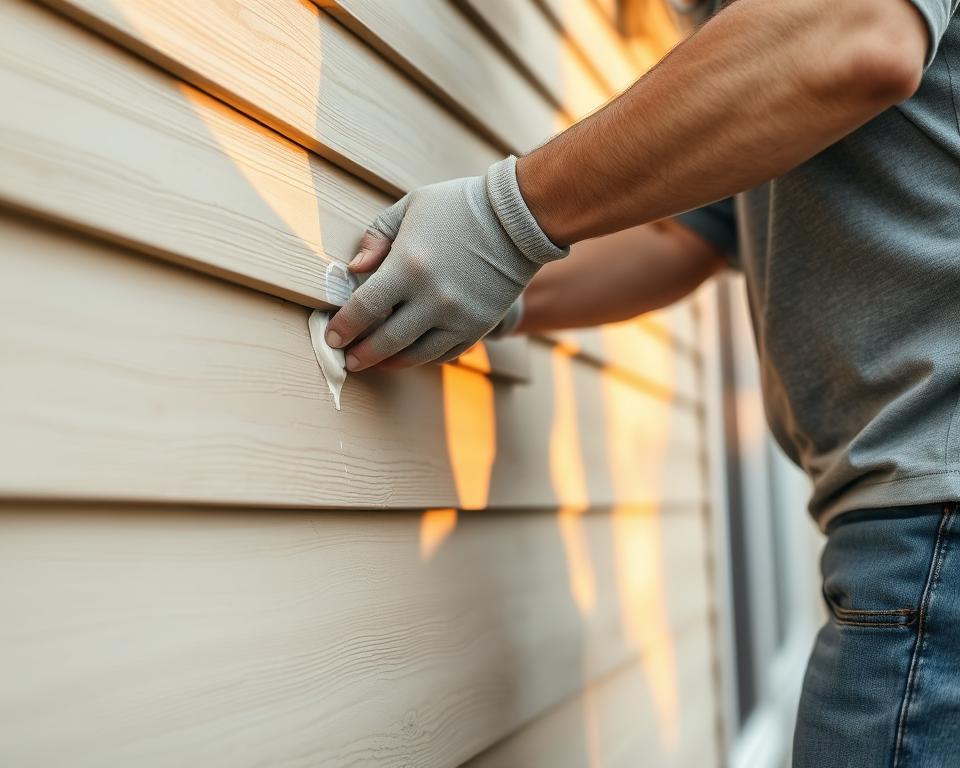
Replacing Damaged Sections
When damage is severe, you might need to replace the siding section.
Tools Required
- Utility knife
- Pry bar
- Hammer
- Nails or siding nails
- Replacement siding panel
Installation Steps
- Take out the damaged siding panel carefully.
- Check and clean the area behind the siding.
- Put in the new siding panel and make sure it’s secure.
- Seal any gaps with caulk.
| Repair Task | Materials Needed | Tools Required |
|---|---|---|
| Repairing Cracks/Punctures | Siding repair compound, caulk, paint | Putty knife, sanding block |
| Replacing Damaged Sections | Replacement siding panel, nails | Utility knife, pry bar, hammer |
Restoring Insulation Properties
After fixing or replacing siding, check the insulation. You might need to replace it if it’s damaged.
By following these steps, homeowners can keep their insulated siding working well and looking good. This protects their investment and boosts their home’s value.
Preventative Maintenance Strategies
Keeping your insulated siding in good shape is key to its longevity. Regular upkeep not only makes your siding last longer but also keeps it working well. This protects your home from the outside world.
Seasonal Care Routine
Having a seasonal care plan is essential for your insulated siding. Each season brings its own set of challenges. Staying ahead can prevent damage.
Spring and Summer Maintenance
In spring and summer, check your siding for winter damage. Look for cracks, dents, and wear around windows and doors. A mild detergent can clean off dirt and grime.
Fall and Winter Protection
As fall and winter come, make sure your siding is ready. Check for gaps or cracks that let cold air or water in. Sealing these can keep your home warm and prevent damage from cold.
Long-Term Protection Products
Using long-term protection products is a smart move for your insulated siding. These products can make your siding last longer and look better.
Sealants and Coatings
Sealants and coatings are vital for protecting your siding. They keep water out, prevent cracks, and keep your siding’s color and texture. Choose based on your siding type and local climate.
Performance Reviews
When picking long-term protection products, check their performance. Look for positive reviews and ratings from other homeowners. Consider durability, ease of use, and compatibility with your siding.
By following these preventative maintenance tips, you can make your insulated siding last longer. This ensures your home stays protected.
Conclusion: Protecting Your Investment in Insulated Siding
Keeping your insulated siding in good shape is key to your home’s look and energy use. Knowing about different siding types, spotting damage early, and fixing it right can make your siding last longer.
Regular upkeep is vital. This includes cleaning your siding seasonally and using protective products. Doing this helps avoid expensive fixes, saves energy, and keeps your home looking great.
Fixing and caring for your insulated siding is good for your wallet and your comfort. Being proactive and informed helps you enjoy your siding for many years. So, protecting your insulated siding is a smart choice.



